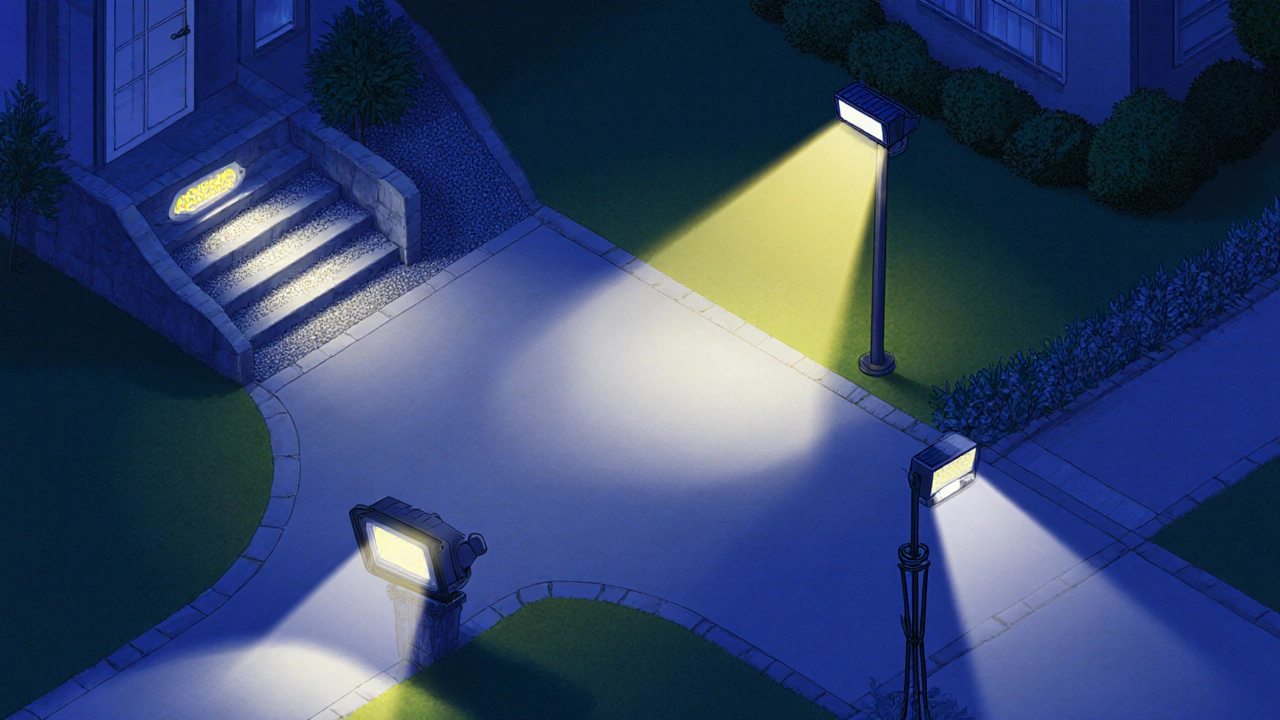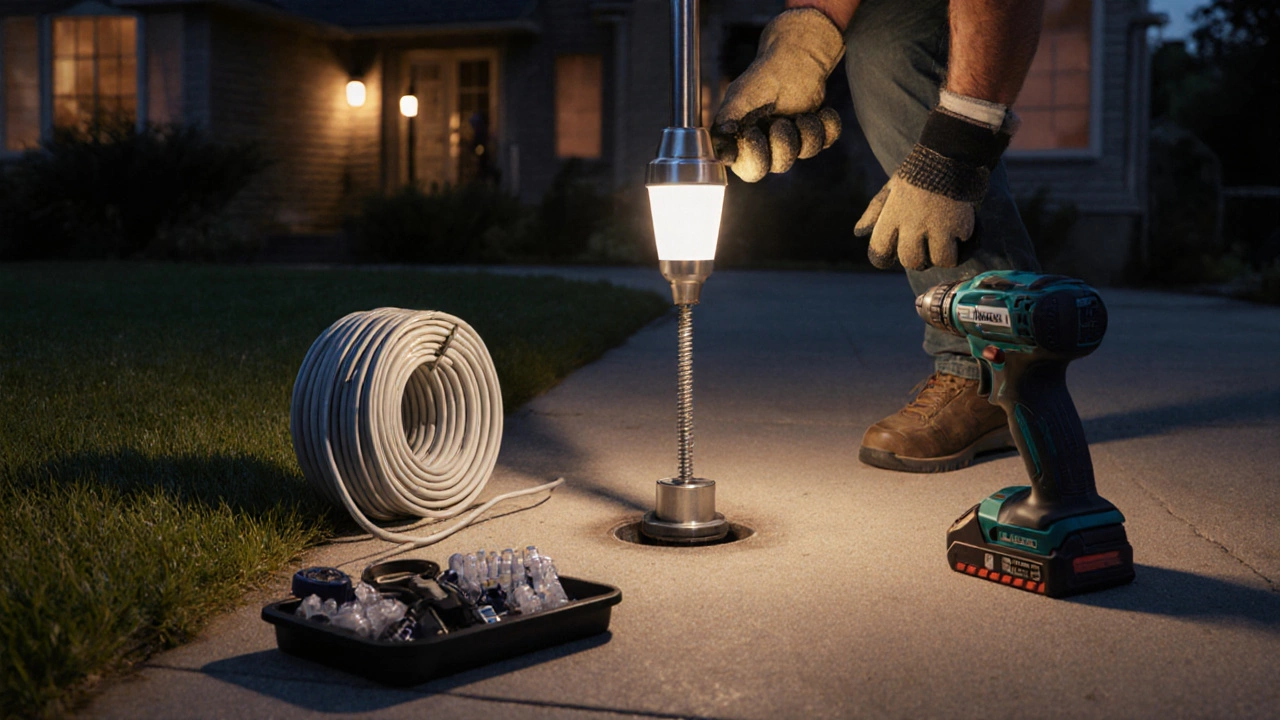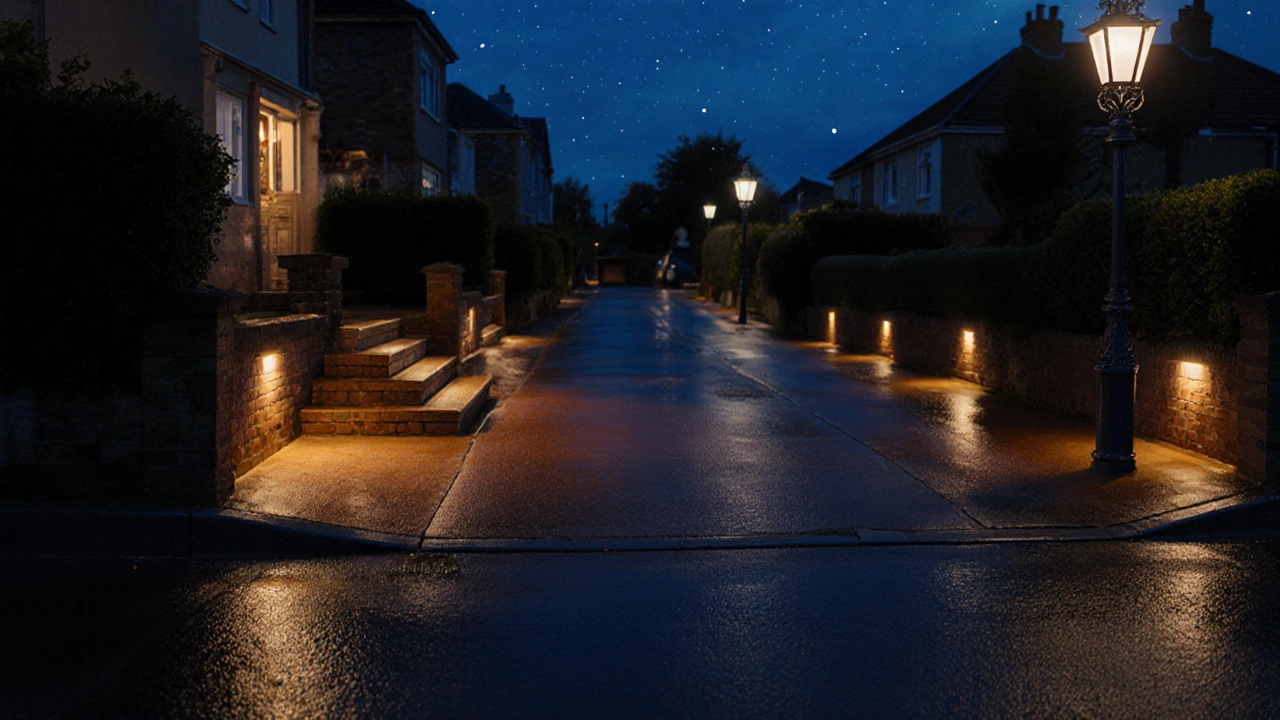When you look for lighting to brighten the entrance, Driveway lights are outdoor fixtures designed to illuminate the driveway area, improve safety and boost curb appeal. Most homeowners simply call them “driveway lights,” but the market uses a handful of specific names that tell you exactly how a fixture works and where it belongs.
Common Names You’ll Hear
Understanding the jargon makes it easier to shop and to talk to an electrician. Here are the most frequently used terms:
- Path lights are low‑profile fixtures placed along the edge of the driveway or walkway to guide the eye.
- Step lights are recessed or surface‑mounted lights built into the steps leading up to a garage or front door.
- Floodlights are high‑output fixtures that cast a broad beam across the entire driveway.
- Pole lights (or post lights) are mounted on a tall pole at the driveway’s end, providing both illumination and a decorative element.
- LED driveway lights refer to any driveway fixture that uses LEDs as the light source, offering long life and low power draw.
- Solar driveway lights harness sunlight during the day and switch on automatically at dusk.
- Motion‑activated lights stay off until a sensor detects movement, then brighten the area for a set time.
How the Types Differ
Each name does more than sound fancy; it signals a set of attributes that affect brightness, energy use, cost, and placement.
| Type | Typical Light Source | Usual Placement | Brightness (lumens) | Power Source | Typical Cost (AU$) |
|---|---|---|---|---|---|
| Path lights | LED | Along edges, 0.5‑1m apart | 100‑300 | Hard‑wired or solar | 30‑80 |
| Step lights | LED | Embedded in steps or nosing | 80‑200 | Hard‑wired | 50‑120 |
| Floodlights | LED / Halogen | Mounted on walls or poles | 1,000‑5,000 | Hard‑wired or solar | 70‑200 |
| Pole lights | LED | On decorative posts at driveway end | 300‑800 | Hard‑wired or solar | 90‑250 |
| Solar lights | LED | Anywhere with sun exposure | 50‑600 | Solar battery | 20‑100 |
| Motion‑activated | LED | Strategic points, often on floodlight bodies | 500‑2,000 | Hard‑wired or solar | 80‑180 |
Choosing the Right Lights for Your Driveway
Here’s a quick decision flow that helps you match a fixture to your needs:
- Goal: Safety vs. aesthetics vs. security.
- If you mainly want to see the pavement, pick path lights or step lights.
- If you need to deter intruders, floodlights or motion‑activated lights work best.
- Power availability: Does the driveway have easy access to electricity?
- With wiring nearby, go for hard‑wired LEDs for consistent brightness.
- If wiring is a hassle, solar fixtures give you freedom.
- Budget: How much are you willing to spend?
- Solar path lights are the cheapest entry point.
- High‑output floodlights cost more but cover larger areas.
- Style: Do you want a modern look or something classic?
- Minimalist LED strips blend into the curb.
- Ornamental pole lights add a decorative flourish.
Combine more than one type for the best result-e.g., solar path lights for guidance plus a motion‑activated floodlight for security.

Basic Installation Tips
Even if you’re not a licensed electrician, many driveway lights are DIY‑friendly. Follow these safety‑first steps:
- Turn off the circuit at the breaker before you start any wiring.
- Mark the exact spot where each fixture will sit. Use a level to keep them straight.
- Drill pilot holes, then secure the mounting brackets with stainless‑steel screws (they resist rust).
- Run+neutral+ground wires in a conduit that’s rated for outdoor use. For solar units, simply snap the base into the ground.
- Connect the wires according to the fixture’s wiring diagram. Tighten all connections with a waterproof connector.
- Seal any openings with silicone caulk to keep moisture out.
- Switch the power back on and test the lights. Adjust the tilt on floodlights to avoid glare into the street.
If local regulations require a permit for hard‑wired exterior lighting, apply before you start. In Adelaide, the council generally allows residential outdoor lighting without a permit as long as it meets the Australian Standard AS/NZS 3000.
Maintenance and Longevity
Good lighting lasts years, but a little upkeep keeps it performing at its best.
- Clean the lenses twice a year-dust and pollen can cut brightness by up to 20%.
- Check solar panels for shading from new plant growth.
- Replace LED modules every 5‑7years; the housing often stays usable.
- Inspect wiring for corrosion especially after heavy rains.
- For motion sensors, adjust sensitivity to avoid false triggers from pets.
Most manufacturers offer a 2‑year warranty on workmanship and a 5‑year warranty on the LED chips.

Frequently Asked Questions
What is the difference between a floodlight and a pole light?
A floodlight is defined by its wide, powerful beam and can be mounted on a wall, roof or pole. A pole light, also called a post light, is primarily a decorative fixture placed on a tall pole; it may use a floodlight style bulb but its purpose often includes style as well as illumination.
Are solar driveway lights bright enough for safety?
Modern solar LEDs can produce 300‑600 lumens, enough to clearly see the driveway surface. Pair them with a motion sensor so the light ramps up when someone approaches, giving extra safety without draining a battery.
Do I need a separate switch for driveway lights?
Hard‑wired fixtures can be wired to an existing exterior light switch, or you can install a dedicated timed or motion‑controlled switch. Solar units usually include a built‑in timer and need no separate switch.
Can I use regular indoor bulbs in outdoor driveway lights?
No. Outdoor fixtures must be rated for IP65 or higher to resist moisture. Indoor bulbs can fail early and pose a safety risk.
How far apart should path lights be spaced?
A spacing of 0.5‑1meter provides a continuous line of light without dark gaps. Wider gaps work if you use higher‑output LEDs.
Next Steps
Now that you know the names, differences, and basics of installation, pick the type that fits your driveway’s size, style, and security needs. Start by measuring the length of the driveway, then sketch a simple layout showing where each fixture will go. If you’re unsure about wiring, call a local electrician for a quick quote-most jobs in Adelaide take under two hours and cost between $120‑$200 per hour.
Finally, purchase a few extra LED modules and a waterproof connector kit; they’re cheap insurance against future failures. With the right driveway lights, you’ll enjoy a safer, more welcoming home every night.

